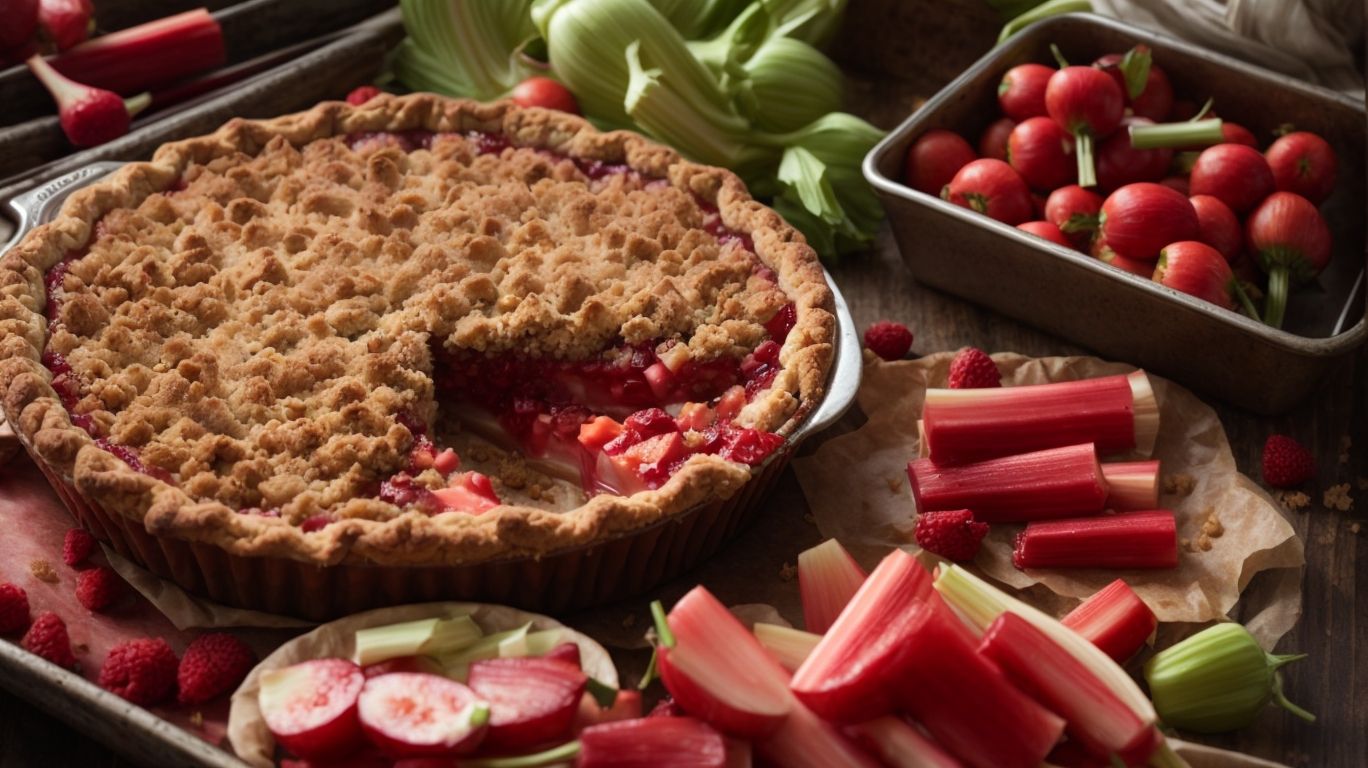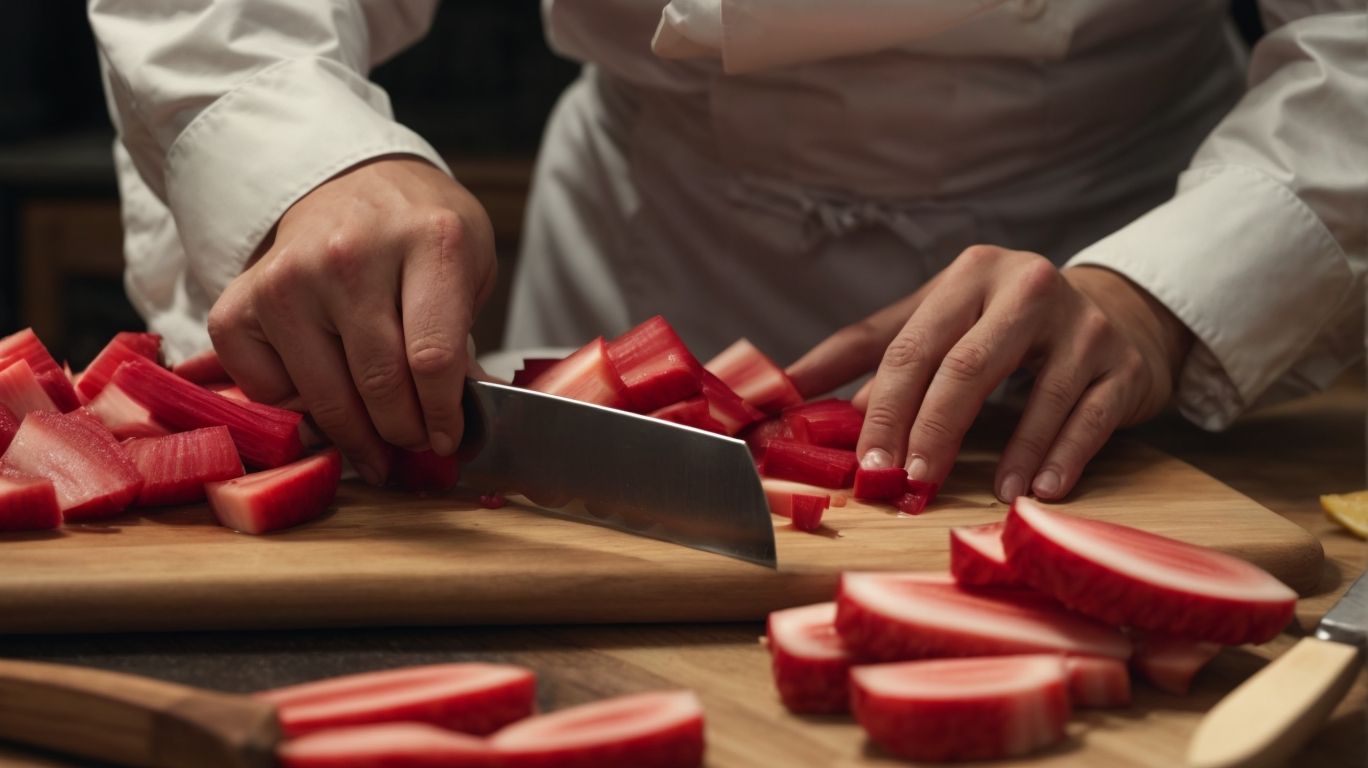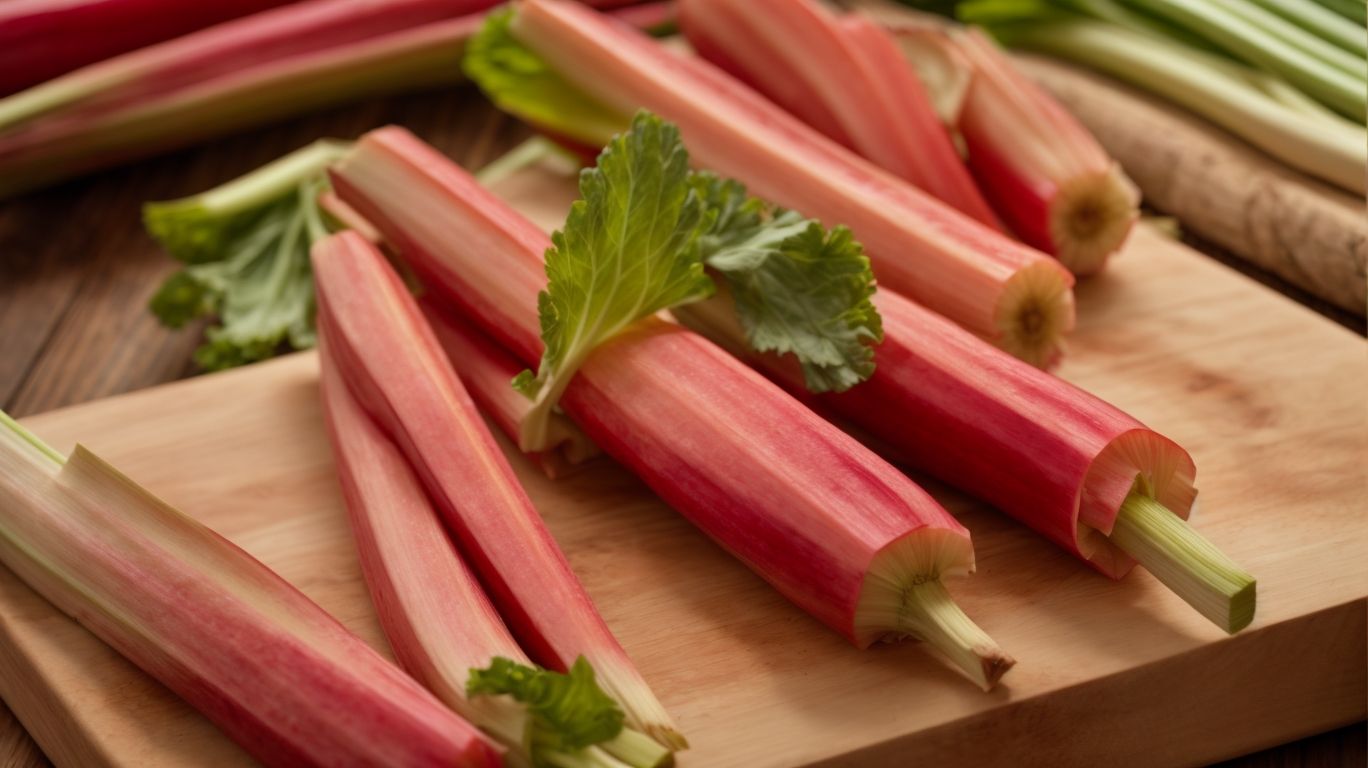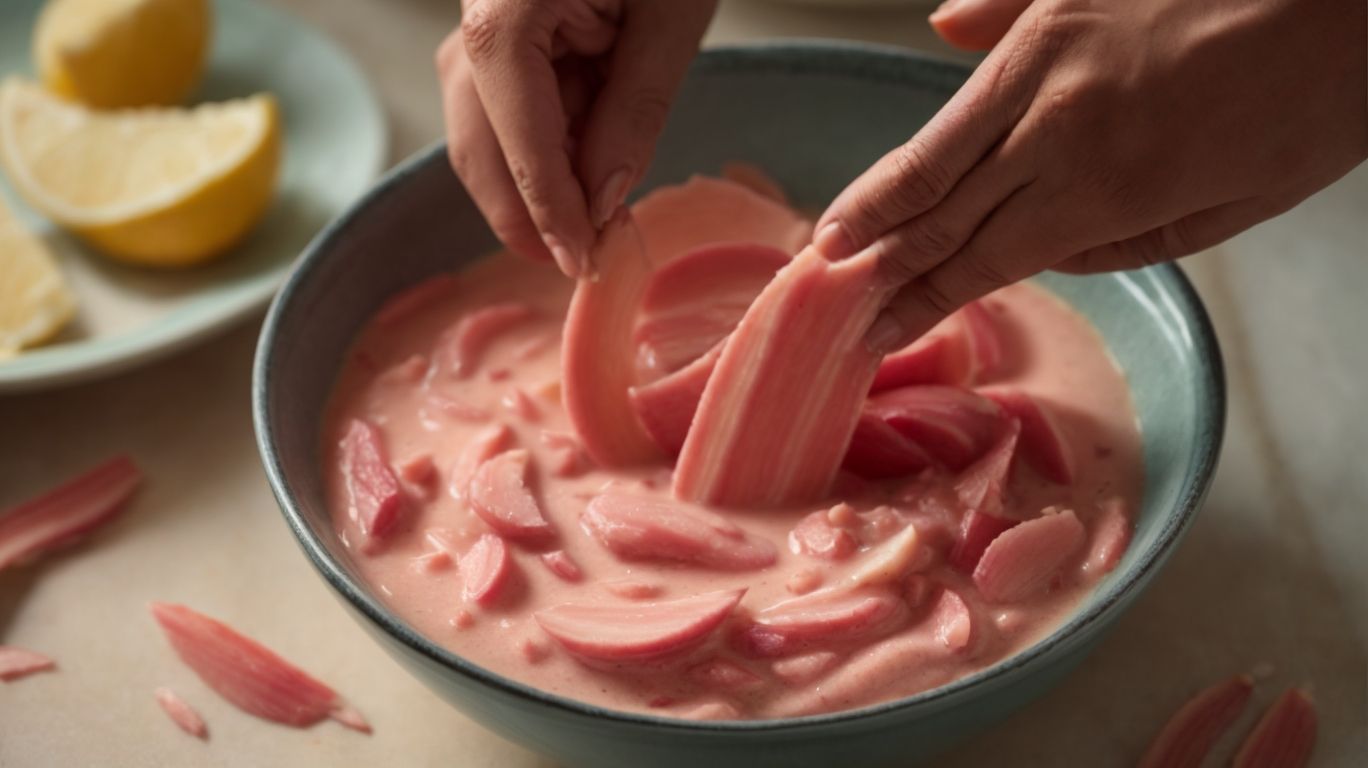How to Bake With Rhubarb?
Looking to add a unique and tangy twist to your baked goods?
Rhubarb is the answer!
We will explore everything you need to know about this versatile ingredient.
From the different types of rhubarb to tips on choosing and storing it, we’ve got you covered.
Find step-by-step instructions on how to prepare rhubarb for baking and discover some delicious recipes to try.
Let’s get baking with rhubarb!
Key Takeaways:
What is Rhubarb?
Rhubarb is a versatile plant known for its tart flavor, often used in baking and cooking.
Its unique taste adds a tangy kick to pies, tarts, jams, and compotes. Rhubarb is low in calories and high in fiber, making it a nutritious addition to various dishes. Due to its vibrant pink or red color, it is also favored for its aesthetic appeal in culinary creations. Chefs and home cooks alike value rhubarb for its ability to balance sweet desserts with a hint of sourness, creating a delightful contrast in flavors.
What Does Rhubarb Taste Like?
The flavor of rhubarb can be described as a unique combination of tartness and sweetness, appealing to adventurous taste buds.
Its tartness provides a sharp, tangy punch, while the sweetness balances out the overall flavor profile. Rhubarb’s bold taste pairs well with a variety of ingredients, such as strawberries, for a classic combination in pies and jams. It can also be used in savory dishes, where its acidity adds depth, like in a rhubarb chutney served with grilled meats. Its versatility shines in beverages, where it can be transformed into refreshing cocktails or mocktails by leveraging its unique taste.
What Are the Different Types of Rhubarb?
There are several varieties of rhubarb, including traditional red rhubarb and less common green varieties.
Aside from the well-known red rhubarb, there are other varieties such as the vibrant Victoria rhubarb which has a beautiful pinkish hue and a delicate flavor. In contrast, the Timperley Early rhubarb features a distinctive deep crimson color and a more intense tartness. The Sutton rhubarb, on the other hand, is prized for its tender texture and slightly sweeter taste.
In terms of culinary uses, red rhubarb is often preferred for its bold color in jams, pies, and compotes, while the green varieties like the Glaskins Perpetual rhubarb offer a milder taste, perfect for fresh eating or salads. The different colors and flavors of rhubarb allow for a versatile range of culinary creations, catering to various preferences and dishes.
How to Choose and Store Rhubarb?

Credits: Poormet.Com – George Nelson
Selecting fresh rhubarb is essential for ensuring optimal flavor and texture in your recipes.
When choosing rhubarb at the market or grocery store, look for stalks that are firm and brightly colored. Avoid any limp or wilted stalks, as they indicate age and potential loss of flavor. Fresh rhubarb should have a crisp texture and a vibrant hue, ranging from pale pink to deep red, depending on the variety. Remember that thinner stalks tend to be more tender and sweeter, while thicker ones can be more fibrous.
Check the leaves attached to the stalks – they should be dark green and fresh-looking, with no signs of wilting or yellowing. Rhubarb with recently trimmed leaves indicates freshness. Once you’ve selected your rhubarb, store it in the refrigerator in a perforated plastic bag to maintain its moisture and crispness. It’s best to use rhubarb within a few days of purchase to enjoy its peak flavor.
What to Look for When Buying Rhubarb?
When purchasing rhubarb, seek stalks that are firm, brightly colored, and free from blemishes.
Additionally,
- Check the leaves of the rhubarb – they should be vibrant green and not wilted, as this indicates freshness.
- The stalks themselves should have a crisp texture when snapped, a sign of their optimal ripeness.
- Remember that thinner stalks tend to be more tender and flavorful, perfect for pies and desserts, while thicker stalks work well for savory dishes like chutneys.
- Look for rhubarb that feels heavy for its size, a good indication of juiciness and plumpness.
- Ultimately, choosing high-quality rhubarb will greatly enhance the flavor of your culinary creations.
How to Properly Store Rhubarb?
To store rhubarb, wrap the stalks in a damp paper towel and place them in the refrigerator to maintain freshness.
It is important to note that rhubarb is a highly perishable vegetable and needs to be stored correctly to prolong its shelf life. Keeping rhubarb at a constant temperature of around 32°F (0°C) in a refrigerator helps retain its crispness and flavor. Avoid washing rhubarb before storing it, as excess moisture can lead to mold growth. For longer-term storage, consider freezing rhubarb. Simply wash, chop, and freeze the stalks in sealed containers. Properly stored frozen rhubarb can last for up to a year, allowing you to enjoy this tangy vegetable even when it’s out of season.
Preparing Rhubarb for Baking

Credits: Poormet.Com – Larry Baker
Before baking with rhubarb, it’s crucial to clean and trim the stalks to remove any tough fibers and prepare them for use in recipes.
One method to clean rhubarb is by rinsing them under cold water and gently rubbing the stalks to remove any dirt or debris. Then, using a sharp knife, trim off the ends of the stalks and discard them.
Trimming the rhubarb involves cutting the stalks into the desired size for your recipe. Whether it’s slicing them into thin pieces for a pie or chopping them into chunks for a crumble, the goal is to ensure uniform pieces that cook evenly.
Enhancing the flavor of rhubarb can be done by lightly sprinkling sugar over the cleaned and trimmed stalks and letting them sit for a few minutes. This helps to mellow out the tartness and draw out some of the juices.
How to Clean and Trim Rhubarb?
Cleaning and trimming rhubarb involves washing the stalks, removing any leaves, and cutting them into pieces as per the recipe requirements.
Start by rinsing the rhubarb under cool running water to remove any dirt or debris. Use a vegetable brush to gently scrub the stalks for thorough cleaning. Ensure to remove all the leaves as they are toxic and should not be consumed.
The next step is to trim off the ends of the stalks, discarding any tough or discolored parts. To prepare the rhubarb for your dish, cut it into evenly sized pieces, whether diced for a pie or sliced for a compote.
What Parts of Rhubarb Can You Use for Baking?
For baking purposes, the stalks of the rhubarb plant are the primary parts used, often combined with ingredients like eggs, butter, cinnamon, and flour.
When incorporating rhubarb into baked goods, the tartness of the stalks complements the sweetness of desserts like pies, crumbles, and tarts. The juicy texture of rhubarb adds a delightful moistness, enhancing the overall mouthfeel of the final delicacy. It pairs exceptionally well with sugar, acting as a natural sweetener to balance out its sharpness. Rhubarb’s vibrant pink hue not only adds visual appeal but also indicates its tenderness and freshness, making it an attractive element in various baked treats.
Recipes for Baking with Rhubarb
Explore a variety of delightful recipes for baking with rhubarb, including classic rhubarb crisp, rhubarb streusel muffins, rhubarb custard pie, and rhubarb and strawberry galette.
For a classic rhubarb crisp, gather fresh rhubarb stalks, sugar, flour, and oats. Combine the chopped rhubarb with sugar and a hint of cinnamon for sweetness. Create a crumbly streusel topping from oats, flour, and butter, layer it over the rhubarb mixture, and bake until golden brown and bubbly.
When making rhubarb streusel muffins, mix flour, sugar, baking powder, and salt in a bowl. Fold in diced rhubarb for a tangy twist. Top each muffin with a crunchy streusel mixture made from butter, flour, and sugar before baking to perfection.
For a decadent rhubarb custard pie, use a flaky pie crust to hold a creamy custard filling mixed with tart rhubarb chunks. Sprinkle a touch of nutmeg over the top before baking for a subtle spice note.
Indulge in a rustic rhubarb and strawberry galette by arranging slices of rhubarb and strawberries on a pastry dough round. Fold the edges over the fruit, and sprinkle with a crisp streusel topping of flour, sugar, and butter. Bake until the crust is golden and the filling is bubbly and fragrant.
Classic Rhubarb Crisp
The classic rhubarb crisp is a timeless dessert that combines the tartness of rhubarb with a sweet streusel topping, creating a perfect balance of flavors.
To make the delicious classic rhubarb crisp, you’ll need 4 cups of fresh rhubarb, washed and chopped, 1 cup of granulated sugar, 1/4 cup of all-purpose flour, a pinch of salt, and 1 teaspoon of vanilla extract. For the streusel topping, gather 1 cup of old-fashioned oats, 1/2 cup of packed brown sugar, 1/3 cup of all-purpose flour, and 1/2 cup of softened butter.
Preheat your oven to 350°F and mix the rhubarb with sugar, flour, salt, and vanilla extract in a large bowl. In a separate bowl, combine the oats, brown sugar, flour, and butter until crumbly.
Spread the rhubarb mixture in a baking dish, then sprinkle the streusel topping evenly over it. Bake for about 45-50 minutes until the topping is golden brown and the rhubarb is bubbly.
Once done, let it cool slightly before serving. This delightful dessert pairs well with a dollop of vanilla ice cream or a drizzle of fresh cream, adding a creamy touch to the tangy rhubarb flavors.
Rhubarb Streusel Muffins
Indulge in the delightful combination of rhubarb and streusel in these moist and flavorful muffins, perfect for a breakfast treat or afternoon snack.
Start by preheating your oven to 375°F and lining a muffin tin with paper liners.
In a mixing bowl, combine the dry ingredients including all-purpose flour, baking powder, and a pinch of salt to create a light and fluffy batter.
Next, incorporate the wet ingredients like eggs, melted butter, freshly diced rhubarb, and a splash of vanilla extract for added sweetness.
Once the batter is well mixed, spoon it into the muffin tin, filling each cup about two-thirds full.
For the streusel topping, mix flour, brown sugar, and cold butter until crumbly, then sprinkle it over the muffin batter.
Rhubarb Custard Pie
Savor the rich and creamy goodness of rhubarb custard pie, a delectable dessert that combines the tangy notes of rhubarb with a luscious custard filling.
To create this delightful treat, start by gathering fresh rhubarb stalks, eggs, sugar, milk, flour, and a hint of vanilla extract. Preheat your oven and prepare a flaky pie crust in a pie dish. The preparation involves cooking the rhubarb with sugar until soft, then blending it into a smooth puree. Whisk together the custard ingredients until silky and pour it over the rhubarb base. Bake the pie until the custard is set and golden. Let it cool before serving for the perfect balance of sweet and tangy flavors.
Rhubarb and Strawberry Galette
Experience a burst of flavors with the rhubarb and strawberry galette, a rustic pastry that showcases the natural sweetness of strawberries alongside the tanginess of rhubarb.
Creating a rhubarb and strawberry galette is not just about combining two delicious fruits; it’s a culinary adventure that marries sweet and tart notes in a buttery crust, creating a delightful contrast of flavors and textures. To begin, prepare the galette dough using a blend of flour, butter, sugar, and a hint of salt, ensuring a crisp and flaky base for the vibrant fruit filling.
Slice the rhubarb and strawberries thinly, allowing them to nestle closely together on the dough, forming a visually appealing pattern that intensifies the visual appeal of this dessert. A sprinkle of sugar on top of the fruit before folding and pleating the edges of the pastry adds a caramelized touch that enhances the overall taste.
Tips for Baking with Rhubarb

Credits: Poormet.Com – Edward Wilson
Enhance your baking experience with rhubarb by exploring these essential tips, such as pairing rhubarb with sweet fruits, incorporating it in savory dishes, adding citrus for balance, and experimenting with spices and herbs.
Rhubarb’s unique tartness can be beautifully complemented by the sweetness of strawberries, raspberries, or even apples in desserts like pies or crumbles.
For savory options, consider adding rhubarb to dishes like chutneys, sauces, or salads to bring a surprising zing to your meals.
To enhance the flavor profile further, squeeze a bit of lemon juice over your rhubarb creations to balance out the tang.
Don’t be afraid to get creative with spices like ginger, cinnamon, or even rosemary to elevate the taste of your rhubarb concoctions.
Pair Rhubarb with Sweet Fruits
Combining rhubarb with sweet fruits like strawberries or apples can elevate the dessert’s flavor profile, creating a harmonious blend of tartness and sweetness.
When rhubarb is paired with strawberries, the natural tartness of rhubarb beautifully complements the sweetness of the strawberries, resulting in a vibrant and well-balanced dessert. This flavor combination not only tantalizes the taste buds but also offers a nutritional boost. Rhubarb is a good source of vitamin K, vitamin C, and antioxidants, while strawberries bring their own set of nutrients to the table, like vitamin C and fiber.
Incorporating rhubarb and sweet fruits in baked goods such as pies, crisps, or crumbles can introduce a wonderful textural contrast, with the rhubarb retaining a slight crunch amidst the softness of the fruits. The visually appealing contrast of red rhubarb stalks against the vibrant colors of strawberries or apples adds to the overall aesthetic of the dessert.
Use Rhubarb in Savory Baked Dishes
Explore the versatility of rhubarb by incorporating it into savory dishes, such as roasted meats, sauces, or chutneys, adding a unique tangy flavor to your culinary creations.
Rhubarb’s tartness pairs beautifully with savory flavors, creating a delightful contrast in dishes like rhubarb-glazed pork loin or rhubarb barbecue sauce for grilled chicken.
For a creative twist, try incorporating rhubarb into savory tarts or galettes, combining it with herbs like thyme or rosemary to enhance its flavor profile.
Experiment with pickling rhubarb to add a tangy kick to charcuterie boards or as a garnish for roasted vegetables, offering a refreshing and unexpected element to your dishes.
Add a Touch of Citrus to Balance the Tartness
To offset the tartness of rhubarb, consider adding a hint of citrus zest or juice to your baked goods, enhancing the overall flavor profile and adding a refreshing twist.
When incorporating citrus flavors with rhubarb, think about the natural acidity and brightness that citrus fruits can bring to the table. Lemon, orange, or even grapefruit can complement rhubarb beautifully, creating a balanced blend of sweet and tangy notes.
For recipe adjustments, you can try reducing the amount of sugar slightly when adding citrus, as the citrus itself brings a level of sweetness. Experiment with different citrus varieties to find the perfect match for your rhubarb creation.
Culinary tip: Try incorporating finely grated lemon zest into your rhubarb crumble topping for an extra pop of flavor!
Experiment with Different Spices and Herbs
Elevate the taste of your rhubarb creations by experimenting with a variety of spices and herbs, such as cinnamon, ginger, mint, or basil, to add depth and complexity to your dishes.
Combining spices like cloves or cardamom with rhubarb can bring a warm and aromatic element to your recipes. For a refreshing twist, try pairing rhubarb with rosemary or thyme for a subtle earthy note that complements its tartness. Experimenting with different cooking methods, whether roasting, stewing, or incorporating into baked goods, can unlock new dimensions of flavor in your rhubarb dishes. Don’t hesitate to get creative in the kitchen with flavor enhancements, as rhubarb’s tangy profile lends itself well to a variety of complementary ingredients and techniques.
Frequently Asked Questions
1. How to Bake With Rhubarb?
Baking with rhubarb is easy and versatile, adding a unique tart flavor to sweet treats. Follow these simple tips for successful rhubarb baking.
2. What is the best way to prepare rhubarb for baking?
Wash and trim the rhubarb stalks, removing any brown or tough ends. Cut into small pieces, about 1/2 inch thick, for even cooking.
3. Can I use frozen rhubarb for baking?
Yes, you can use frozen rhubarb for baking, but be sure to thaw it completely and drain any excess liquid before adding it to your recipe.
4. How can I prevent my rhubarb desserts from turning too watery?
To prevent excess liquid in your rhubarb desserts, sprinkle the chopped rhubarb with sugar and let it sit for about 30 minutes before using. This will draw out some of the water and concentrate the flavor.
5. What are some popular desserts that use rhubarb?
Rhubarb is a popular ingredient in pies, crumbles, and cobblers, but it can also be used in cakes, muffins, and even cocktails.
6. Can I substitute rhubarb for other fruits in baking?
Rhubarb has a unique tartness that can be difficult to substitute. However, tart apples or cranberries can be used as alternatives in some recipes. It’s best to experiment and see what works best for your taste preferences.

